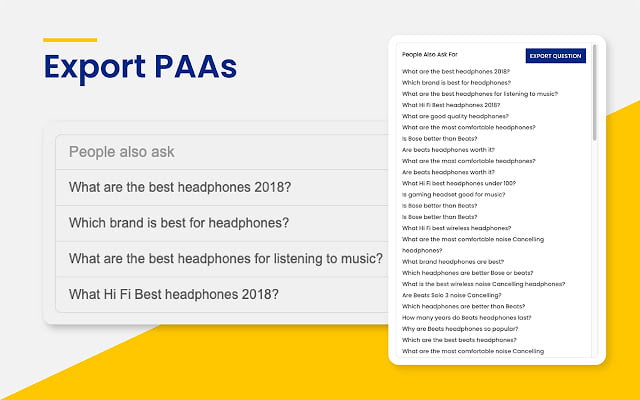Starting a SaaS business is all the rage these days as tech founders are veering away from the sexy consumer tech startups with zero revenue. They are constantly finding a safe space in an industry familiar with quick profits. According to Reuters, the SaaS market is anticipated to grow at a compound annual growth rate (CAGR) of 21.20% during the forecast period 2010-2023.
I was running a service agency by the name Risemetric, which was already hitting ~$3.2M annual revenue. But then I realized that scaling services/agency business takes a lot of efforts and time. You have to be present in every goddamn meeting and keep sharing weekly reports and etc.
I started talking to people, who have built successful SaaS companies. Almost all of them said the same thing – “Build an MVP and get 10 paying customers”.
They say the first 10 customers are the hardest. Once you have 10 customers paying you real, tangible revenue, that’s a good sign you’ve got a feasible business ahead of you.
Either you’ll get 10 customers and validate the model or, you won’t get 10 customers and you’ll prove the model isn’t viable.
Simple, right? Let’s get started.
Build an MVP and Just Launch! But then they said…
“Minimum Minimum Viable Product” — a product so stupidly simple that if you eliminate even a single part of it, your entire product is useless.
And with this, the goal here was to get 10 people to sign up for $50/mo. That’s a nifty $500 MRR. If you can’t do that without a ton of effort, your idea sucks, and it’s time to try something new.
On that line, we hacked together the first version of Ahrefs. It was a SERP rank tracker. The reason why we chose this product is that back then when we were helping housing.com to hack the growth via SEO avenue, we had to spend hours and hours to obtain the data of ~40000 keywords weekly. This used to take at least 8-12 hours of my time since no tool was capable of working on a scale. So I decided to solve my own problems first.
The first prototype of Ahrefs had 3 main functions:
- A frontend to add your projects with the keywords (be it 100 or 100K) you want to monitor on search engines like Google.
- A cron job which monitors the movement every 24 hours.
- A stripe form to collect payments.
Half of the code was lifted from Github and the other half from Stack-overflow, and it worked. I personally feel that during those early days, the best programmer is the one who knows what to search and how to put various functions together from Stackoverflow and get things going (even if they are little buggy).
We took the idea of having an MVP so literally that it didn’t even have a landing page explaining the product. We wanted users to directly signup and figure out what the hell was going on inside and go from there.
Anyway, now once we have the MVP, it was time to get the word out and get users to try it and give feedback.
So how do you market a SaaS product without even a landing Page and get users?
Ahrefs is a product built for marketers, and being marketers ourselves one thing we know for sure is that.
Selling to marketers is tricky. Doing it at scale is even worse.
Adding to the misery, on the launch day, like I said we didn’t even have a landing page explaining the product, we simply sent them to the signup page. I can’t even explain how crazy is that and will definitely piss-off a lot of marketing gurus.
Driving traffic to high-growth companies is what I did for a living, doing it for own product would be pretty easy, right? There was only a small catch:
They all had a huge marketing budget to spend on either organic or paid traffic. As a bootstrap company, I didn’t have that liberty this time.
So what do we do, we decided to tell our friends and hope they would signup and tell theirs. In an ideal world that’s how it’s supposed to work.
So I tried the usual suspects, making announcements on social media, doing it on twitter and tell our marketing friends from the companies we work in the past. As you have guessed, no one cared. People even stopped replying to texts. People I had spent significant time in helping.
How do you trick people who already know all the tricks in the book?
Being a marketer and then a desperate early-stage SaaS Founder, I started researching about SaaS growth hacks and talked to a few consultants. Some say it’s totally bullshit while others claimed it’s the only thing standing between Ahrefs and it becoming the next HubSpot.
And with all these k̶n̶o̶w̶l̶e̶d̶g̶e̶ hacks in my head, sometimes I Imagine a world where I am not breaking the bank on ads and customers just naturally come to Ahrefs and put their credit card like gazelles at a watering hole.
But then I wake up and it’s this shitty real world, where it takes spamming the living hell out of every unwitting visitor to convert into a paying customer.
And that’s what we’ll be checking out today: Building a SaaS product & scaling it to over $25K MRR in less than 6 months of launch.
If you don’t have a shovel, now’s the time to get it. We’re digging deep!
# 1 – Betraying my own Social network
Over the years, I have built a good network of SEO folks in my friend list by genuinely sharing insights & helping others with no self-agenda.
Now, this was time to get them to work. I offered them a Lifetime FREE Account of the tool if they shared the word about our product on their Facebook wall and tagged me there.
Here is the exact facebook post I made, a small, clearly explaining what they are going to get and how they can get it. (Sorry! I’ve even missed adding og:image tag for the product page back then)
Dozens of People shared the post on their facebook wall and tagged me there.
What they didn’t realize is with each share or tag the product was exposed to over 1000 of their network creating a mini-viral effect and almost everyone in our small SEO community was aware of what we built within 24 hrs.
And here comes the results of this activity:
120 comments
69 Shares
Tons of visitors on the site. A lot of them signed-up (531 users to be exact).
We took building an MVP term so seriously that even putting Google Analytics code into the product was considered as a novelty. So, I didn’t have analytics or any kind of tracking setup back then.
Just an email notification when a user signs up and that’s all I had.
Here is a screenshot showing user signups for that day and the next few days as the momentum was built.
This influx of new users, out of which almost everyone was an SEO and probably paying for another tool right now, not only gave us a huge boost in confidence but also helped us fix bugs, improve the product and make it sellable.
If you are wondering, Yes – 22 of them became paying customers the same week.
We worked closely with these users over the next couple of weeks and gathered tons of feedback and bug requests.
Almost after 2 months of squashing bugs and listening to feedback, we were ready to ship the rocket to the moon. It was time to get on a bigger platform.
And Yes, this time with Analytics installed and all goals setup was in place.
#2 – Piggyback Authority of a huge authority blog
My Co-founder Suumit was up for this, we wanted to be visible to almost everyone who had something to do even remotely with SEO and he knew exactly what to do.
“Hey Glen. My name is Suumit and I wanted to share a case study of how I launched an Amazon affiliate site from scratch and hit $28,000/m in just eight months.”
This is the message he sent to Glen, (And for those of you who don’t know Glen, really? )
Glen was pretty excited with the idea and published a very detailed case study of one of our Amazon Associate website which we scaled from 0 to $28k/m in less than a few months. In the case study, Suumit shared insights on our process, what goes on in building successful Affiliate sites and a lot more. While we didn’t ask for, he himself talked about Suumit next Project (Ahrefs) in the article.
If you haven’t yet, I highly recommend you do give it a read.
Given his reach and the content in it, the article was read by thousands the SEOs around the world, received way more engagement and comments than what we usually see on content blog posts. I mean what was the last time you saw a blog post with 217 comments?
In Glen’s own words –
I didn’t know who Suumit was or how he got my Skype ID, but if you’re going to message me out of the blue, that’s the kind of introduction that will get my attention.
What was the outcome?
We got over a thousand (1382 to be exact) highly qualified direct referral visitors, out of the 59 converted into a Paid Plan. 3 Big agencies also signed up, one of them is currently tracking over 70,000 keywords per week.
Suumit got a lot of inquiries from well-established Businesses Owners willing to hire him for SEO which he politely declined. (Since our focus is on creating a product company and not a service company)
#3 – Bait & Switch on Reddit
Now I wanted to try & Market on Reddit and being a long-time Redditor I know for a fact that these are some of the worlds most un-forgiving folks and don’t even blink before calling your supposed cleaver attempt a BS.
The sub I was trying to target was /r/Entrepreneur/, it’s a community of around 600K entrepreneurs and the folks here are mostly Business Owners or Internet Marketers like us.
While I have been a lurker there for a long time, I didn’t really do any commenting or posting before and for that, account didn’t have any KARMA (Or Credibility).
Here are my attempts to gain eyeballs to Ahrefson that sub.
First attempt:
Just 7 Upvotes and no visibility. Clearly, folks here didn’t like the link and sensed it was a promotional post. It was a failed attempt.
A bit of research said Reddit likes humor & sarcasm, however, coming up with humor isn’t my specialty so waited for the perfect post.
One day I saw a tweet from Marc Köhlbrugge (Founder BetaList) and it seems like just the perfect Reddit material.
I lifted it off and posted it there, within a few hours It got 2 Reddit Golds, 1800 upvotes and 209 comments and was trending as Top post for a week.
Someone noticed I copied it from Twitter and I got called out for that, even Marc commented there. Pretty embarrassing stuff but I got the Karma I wanted.
The takeaway from these 2 posts was, people like to read and will engage with great content, and adding a link in the post decreases the chances of getting a hit.
Basically, selling to marketers is tricky. Trying to sell on Reddit is even worse
How do you trick people who already know all the tricks in the book?
So in the next attempt, I posted a very inspiring story without any links or mention of my product. Just a general genuinely inspiring post.
As expected, the post was a hit and reached the top. I waited until it had 200 Upvotes already And then added a link to Ahrefs with a sentence which closely relates to the post.
Here is the original post and the text I added later highlighted in yellow (Yeah yeah! I know that’s stupid and smart at the same time)
1100 Upvotes, 196 Comments and a TOP post of the month.
It sent 540 Visitors to our landing page and 14 paying customers over the course of one week.
Not bad at all for a few hrs of work.
# 4 – Drug ’em! Building Irresistible Tools for the Industry
Now, these were quick wins and we can’t really replicate them over and over. As a SaaS business, we need to build Long-term sustainable traffic channels and brand awareness.
The next steps towards doing it was to build highly effective tools for the Community and get them to be depended on it for their day to day use.
Being SEOs ourselves we knew a lot about the problems in the industry. And you admit or not, SEO these days is mostly PBNs and Expired Domains (unless you have thousands of dollars to invest in content or months of time to wait for the results). One of the biggest problems in finding an expired domain is to check if they are available for registration.
Sure, you can check on Godaddy one by one or on namebright 5000 at a time (Only supports a handful of TLDs) but that’s not enough when you are trying to repeat it for a shitload of domains on a daily basis.
While running the Agency, I had already solved this problem and built an Internal tool which could check the availability of 100,000 domains in 60 seconds. There is no tool in the market right now which can match either the speed or scale of it.
This tool was and is being loved by the community so far. Here are the uses stats.Bulk domain name availability checker tool stats
As you can see, Over 7000 SEO pros have used it to check the availability of over 203 Million domains. On average, we see 2.5 Million checks a day.
After a couple of weeks, We tracked the use pattern and limited uses to 1 for the non-signed up user. Even a Free trial account works. In the coming weeks it will be limited to only paid users.
Once they sign up for a Free Trial, a 7 days email series kicks in to encourage them to use the core product.
So far it’s been working great for us, we have identified 6 more such tools which will not only increase our organic traffic a lot but also help the community at large.
#5 – Capture Them All – Building a Community of Evangelists
The next logical step in our long-term strategy was to build a community around SEO, a community which is not subjected to spam but rather engaged in meaningful discussions, encouraged to ask questions and share their knowledge with peers.
We build a Facebook group by the name “ SEO ” for that and started sharing real insights and quality posts. Within a short time, we have over 500000+ members and its growing consistently.
We, the founders dedicate at least 30 minutes of our personal time for the group every day and help users with their questions, lead discussions on trending topics and share insights.
Here is a screenshot showing engagement activities on our posts from the last 4 weeks. That’s close to 60% of the members reading every single post we post there.
I have been part of at least a hundred FB groups so far and most of them have tens of thousands of members with very low activity. Product or commercial groups are even worse.
Looking at our Total members vs Active members (93% active members), I know the efforts have been totally worth it. We continue to maintain the same momentum going forward and aim to build one of the most engaging and knowledgeable communities of SEO Folks.
Growth Stories from 5 fellow SaaS founders
And let’s be real, What worked for companies like Dropbox, Airbnb and bunch of others won’t necessarily work for you and we have heard their stories countless times already.
Given the hunger of Growth and lack of money/resources, people tend to get out of their comfort zone and do things that they normally wouldn’t.
Today I wanted to share stories from common people like us who are new, still growing and is relevant in today’s world.
I reached out to our fellow SaaS founders from industry to hear about such unusual ideas they tried successfully and here is what they had to say.
First up is Ryan Kulp from Fomo (which is one of my favorite SaaS product)
Ryan Kulp from Fomo.com – Building Loyal evangelists
When our product reached a “mature” state in terms of features, we decided to dig in deeper with power users. To do this we created a simple toggle inside every Fomo customer’s user profile called “Rapid Release.” when a Fomo customer enables Rapid Release this adds a special CSS class to various beta features in our app and also enrolls them in a small, intimate newsletter sent directly by me, the founder.
Now, whenever we have an experimental idea or pre-order opportunity for a product that doesn’t exist yet, we simply reach out to our Rapid Release customers who have self-identified as Fomo evangelists. doing so has helped us pre-sell thousands of dollars in feature upgrades prior to writing any code on at least a few occasions. not only does this add value to our best customers, who feel heard because we treat them differently, but it allows us to ship wacky ideas without having to be judged by our entire 27,000 marketer subscriber list.
Then I reached out to Bhanu Ahluwalia, who is a serial entrepreneur who built companies like MyThemeshop and currently working on Rank Math. Here are the thoughts of Bhanu about growth hacking for SaaS product.
Bhanu Ahluwalia from RankMath – WordPress SEO Plugin
Among the most critical parts of Rank Math’s growth strategy was partnering with other companies in the WordPress space, encouraging users to register on our website and encouraging them to sign up to our email list. I suppose it wouldn’t be wrong to say we’re lucky that almost everyone welcomed the Rank Math plugin with open arms because our development and support teams are dedicated to providing an amazing experience with an easy-to-use yet powerful plugin as well as best-in-class support. We never give up until we’re able to give a definitive solution to the issue opened by one of our users on any of our various support channels.
Our focus on the support has not only played a huge role in helping us improve Rank Math, but it has also contributed to why so many people have become a fan & decided to help us spread the word on their own.
P.S. Here’s one of the recent examples where the other plugin refused to help and when the user came to us, we were more than happy to assist:
https://wordpress.org/support/topic/yoast-seo-no-titles-no-meta-description-no-tags/#post-11807593
Then I reached out to Steve Toth from FreshBooks, who has been experimenting with few crazy growth hacks.
Steve Toth from FreshBooks – Win your users with Helpful Free tools
Building free tools is a great way to attract users who have an interest in your product or a particular feature of your product. I head up SEO strategy at FreshBooks and in our case that feature was invoicing. We created hundreds of different invoice templates and pages to attract all the longtail variations of that keyword.
Although we were just giving away free Word, PDF, Excel, Google Sheets, and Google Docs invoice templates, we knew that anyone who was ready to create an invoice could potentially be a FreshBooks customer. It was a long road since we were not even on the first page in late 2018, but our ascent began in January 2019.
That January SEO free trial numbers grew 100% YOY and we saw a minimum 25% MOM growth until reaching the ceiling for that cluster of keywords. It only took us143 days to surpass total trial volume accumulated in 2018.
Invoice templates had by far the highest keyword volume 90,000 US and 200,000 global monthly searches, but it is one of many free tools we have planned and I’m really looking forward to seeing what that bring is in Q3/Q4 !
It’s been a lot of fun ranking that SERP and I have employed similar strategies for my freelance clients. I also run seonotebook.com where I share a page from my SEO strategy notebook each week.
Next up we have Vuk from Lemlist, who got some insane growth hacks around building community on Facebook.
Vuk from Lemlist – everything starts with the Community
Vuk, Head of Growth at Lemlist, an email personalization platform, shares the same thoughts as ours on building a community and have seen consistent growth from their highly engaged community of marketers.
One of the key growth pillars of lemlist was growing a community. The goal was to stick with email outreach as the main topic and keep this highly relevant for entrepreneurs looking to use cold emails as one of their growth channels. That’s how the community got created. Not only has it developed into one of our biggest distribution channels in terms of content and people learning the ins and outs of the product thus driving usage, but it became so much more.
In terms of growth, there are two reasons why the Email Outreach Community played such a significant role. For starters, it gave us a clear path to communicate and produce as much value as we could for our audience. Whether that were specific features or various cold email templates, the game was always to provide value and help them win. With the winning, we were winning sequentially.
Secondly, it opens the gates for their feedback. Our job is always to listen to. The reason why we end up heaving competitive features or why we get instant updates about our competitors is because our clients appreciated us going the extra mile and rewarded us with their ideas and quick videos of what our rivals were up to. Facebook community stats
The best thing is that everything starts in that community. So we kept growing it, listened carefully and continued to focus on providing, instead of extracting value.
I then reached out to Kaloyan Yankulov, who leveraged LinkedIn platform reach to scale their SaaS product.
Kaloyan Yankulov from Encharge.io – The Linkedin Hack
Kaloyan from Encharge.io, a marketing automation platform, has had great success with LinkedIn even before they launched and here is what he wanted to share with our readers.
We used engagement posts on LinkedIn and Facebook groups to grow our email list to 3,000 people long before our official SaaS launch. We leveraged that audience to pre-sell our product to 50 people, and later acquire the first 10 paying subscribers.
What Is An Engagement Post?
In a nutshell, these are posts that create engagement – likes, shares, comments.
You’ve seen them making the rounds on LinkedIn and Facebook recently.
The formula is simple:
You ask your friends/connections to answer a question or leave a comment. That way, spiking engagement, so the LinkedIn/Facebook algorithms pick up your post and more people outside your network see and comment. In a nutshell, a viral engine.
This post is an example engagement post on my personal LinkedIn profile –
It has been viewed more than 100k times and has over 1k comments. We were able to collect hundreds of email subscribers out of it.
You must build up your LinkedIn and Facebook clout before you start with the engagement posts.
1. Post 2-3 times a week regularly for at least a month.
2. Add people from relevant Facebook and LinkedIn groups.
3. Connect your Gmail accounts with LinkedIn and Import your current email list to grow your social media network instantaneously.
We launched a special lifetime deal to the collected email list 6 months before our product was ready. 50 people made a pre-order and validated the demand for what we’re building.
We leveraged the same email list when we launched Encharge and acquired our first 10 paying customers in the week after our launch.
Next up we have Olga Mykhoparkina From Chanty to share her experience of scaling the SaaS product.
Olga Mykhoparkina From Chanty – Using your biggest fear as your advantage
Olga is Chief Marketing Officer at Chanty, a simple AI-powered team chat. This powerful and free Slack alternative is aimed to increase team productivity and improve communication at work.
Competing with a Giant like Slack is a very bold move and it’s interesting how Olga used it to their own advantage.
We have a team chat app which is a competitor to Slack, so we chose the
keyword “Slack alternative” and decided to rank for it and aiming to get new
visitors and hopefully, users.
This was our process: –
1. Write an article on Slack alternatives*
2. *Write guest posts and build links to this article
3. Convert article visitors into Chanty users*
Using this strategy, we got our blog from 0 to 10,000 visitors per month
in just over a year and we got hundreds of new users. To this day, it’s
Been our most successful strategy for acquiring new visitors and users.
Finally, Pete Silvester of Summits.com kindly contributed his time.
Pete Silvester – Baiting for Featured Snippets
I was the Interim CEO and Growth Marketer for Summits.com – a website for climbing mountains in Asia.
With there were so many established global players taking up the top spots in the search rankings, and with our site taking a while to improve our SERP strength, I decided to completely re-arrange our content to go fishing for ranking in Google’s Featured Snippet so that, once we made the top 10, we’d stand a chance of getting above the Top 3!
How I went about it:
1. For every topic, figure out the top 2 or 3 questions people are asking about it. This can be done easily and cheaply by just looking at the People also ask, Searches related to, and even the predictive responses in the search bar.
2. Answer the top 3 queries with a simple Q&A that either has a paragraph, a dot-point list, or a table.
3. Start every article with that content up front. The spiders won’t care that it’s up to the top but search traffic like quick answers, so it can improve bounce rates and visit durations by giving them what they want up front.
Now that some of our pages are starting to rank in the top 10, almost all of them are getting bumped to the L0 position with the right (most popular) search queries.
PRO TIP:
Finding questions to write their answers can be time-consuming, so we have built this plugin called SERPBar (Download from Chrome Web Store) which will let you fetch all questions from PAAFs [people also ask for] for any search keyword and you can probably try to answer popular questions under your FAQ schema.

What’s the Point? Can everyone replicate this?
What’s your Point Subhash? Can everyone replicate this?
Every marketing manager has a brief given by default – Get us more users/revenue with less budget (be it online or offline). That having said, the hunger for growth and lack of money/resources people tend to get out of the comfort zone and do things that we normally wouldn’t.
I mean I have personally handled over 20 million dollars in marketing spends before starting Ahrefs and once you get addicted to throwing money on ads, it’s very difficult to go back to doing the hard things, and on top of that these things don’t even scale.
Paul Graham, founder of YCombinator have been a well-known advocate of doing things that don’t scale in the early days and we were heavily influenced by that thought.
Let’s be real, what worked for companies like Dropbox, Airbnb and a bunch of others won’t necessarily work for you. No chance in the hell. I can bet my money that even the ideas I shared in this very article won’t work for you. But that doesn’t mean you should not try.
Experiment, Fail & Learn What works for “You”
Scaling things from 0 to over $25K was just the beginning and I will keep trying more growth tactics for Ahrefs in order to achieve the mark of bigger numbers. I’ll keep sharing all experiments and their outputs with you guys so make sure you subscribe to our newsletter (only if you wish).
PS: This quick growth helped us to raise an undisclosed amount of funding from angel investors to scale Ahrefs further. So all I would say is – We ran the runway and now it’s the time to take-Off!
If you are a SaaS founder or growth hacker, we would recommend you reading another interesting article around B2B lead generation by Hunter.io. Feel free to comment some of your best growth hacks below and help thousands of other products to reach their targeted users.
Thank you for reading.







Leave a Comment
You must be logged in to post a comment.